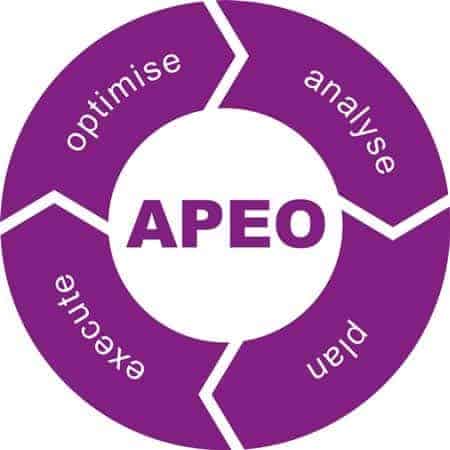The provocative statement, “With our software we manage misery” dates back to 2006, when GIB had just developed the Operations module, a software solution that supports operational activities in scheduling and materials management. Michael Schuster, then Managing Director of GIB, explained that, while the right tool does bring advantages, a company’s processes have to be synchronized and optimized in order to be successful in the long term.
Even then, numerous customer projects showed that there often were communication and information breaks along the internal supply chain, that departments and divisions were always working towards their own individual goals even if these were counterproductive to the overall process and thus to the overall economic performance of the company. This dilemma gave rise to the keywords silo thinking and island optimization.
More than a plug-and-play solution
“It was immediately clear to us that we could not simply deliver a plug-and-play software solution. We also had to talk to our customers about their processes and help them use the new tool,” recalls Volker Bloechl, who joined GIB as a senior consultant in 2008.
GIB is an SAP implementation partner, meaning that expertise in supply chain processes and how they can be managed in SAP always had a firm place in the company. Consequently, it was a logical next step to put together a consulting package for the software. It was designed to show the customer how to use the information and insights gained from the software to optimize their activities and processes.
Today, GIB’s solutions and services support the supply chain process end to end, from sales planning and production planning to inventory and materials management and supplier control. Based in Siegen, Germany, the company has built up expertise in supply chain processes in a wide range of industries. “Whether aircraft or tire manufacturer, shipbuilder or beer brewery, consulting is all about asking the right questions. It is invaluable to know and question issues and solutions from all industries. GIB initiates intensive thought processes and breaks up encrusted structures,” says Bloechl.
“More and more often, we have been asked in projects to take a closer look at our customers’ supply chains, to identify gaps and disruptive factors and to show companies where and how they should optimize their processes,” he reports, and Bjoern Dunkel, also Managing Director of GIB, adds: “I remember many conversations in which supply chain managers thought that we at GIB should tell them how to optimize their processes – weren’t we the specialists, after all?”
With the new SCX Suite on S/4 Hana, GIB will now do exactly that. The concept comprises a strategic and an operational level. On the strategic level, the planning processes are analyzed and optimized using an iterative simulation process. On the operational level, the planning results are incorporated into and processed in process controlling.
Top-down view
The process indicators show how well the respective field (production, inventory and material management, etc.) is performing in real time. By clicking on a process indicator, users can access the key performance indicators (KPIs) which show where the process is stuck. A further click on KPIs leads to the respective transaction, where the irregularities can be identified and corrected.
In daily routines, it seems rather cumbersome if the controller or production planner has to click through all the indicators and KPIs every day to get to their area of activity. Therefore, the software offers role-based access. The user directly finds their field of activity, has all relevant facts and tasks available at a glance, and can start working immediately. The user is shown whether they are currently in the analysis phase, the planning phase, the actual implementation or already in the optimization phase.
Everything starts with the sales plan, with the demand planning process: First of all, companies have to ensure that the relevant materials are accounted for. Planning is calculated for twelve months in advance. Ideally, disruptive inconsistencies in the system, such as missing billing periods and outdated requirements, are now transparent and can be adjusted. The result is an excellent demand planning process.
This sales forecast then flows into production planning (manufacturing) and simultaneously into supplier management (purchasing). Consequently, the sales forecast is made available for all subsequent processes.
What it means
What does this mean for production planning and manufacturing? If you know today what customers will buy tomorrow, you can create a reliable production plan. The planner continues to consider their specific issues and challenges, but has the necessary transparency and information basis to work hand in hand with the upstream and downstream process stages (end-to-end).
What does this mean for supplier management and purchasing? If you know today what customers will buy in the future, then you can negotiate with suppliers in a targeted manner. You can make a partially transparent sales plan and, therefore, make prices, conditions, and quotas cost-efficient, shorten replenishment times or reduce the number of lots.
What does this mean for inventory management (inventory planning)? If you know today what customers will buy in the future, then you can define inventory strategies, e.g. make-to-stock or make-to-order. In addition, strategic targets can be set for inventory key figures, which are then automatically maintained using intelligent sets of rules. These sets of rules additionally automate the maintenance of dynamic material master data if necessary.
No island optimization
The software controls the flow of information and guarantees that each party involved has access to the information relevant to their activity, regardless of the process step in which the information is collected or created.
Mehmet Kozan of Baier und Schneider, who has been working with GIB solutions for years, puts it this way, “I’d say that the greatest benefit is transparency both across departments and within departments. For example, the scheduling department knows how sales planning works now, and production planners suddenly understand it, too.”
Transparency
Transparency and communication are obviously key factors for successful supply chain management, but what other benefits does GIB offer? The indicator model shows the weak points in the process. Only if companies know the issue can they take meaningful action.
The software solution offers every user exactly the information they need in their daily routine. Thus, the field of activity is clearly arranged and easy to use. At the same time, the system prioritizes the fields of activity so that all measures can be initiated in time.
The GIB solution makes success measurable and comparable, making learning from each other easier. The solution ensures the flow of communication. GIB makes silo thinking and island optimization a thing of the past. If all those involved in the process free themselves from the fear that someone else will interfere in their affairs, i.e. if everyone is prepared to cooperate and communicate, then the supply chain will function economically and in a goal-oriented manner, and all involved parties will act in the best interest of the company. A software solution can support, uncover and guide – but the companies themselves must act.
This is the third and last article in a series. If you would like to read the first one, click here.


















![GIB innovation SAP SCX [shutterstock: 526092568, musicman]](https://e3zine.com/wp-content/uploads/2020/09/GIB-innovation-SAP-SCX-shutterstock_526092568.jpg)




Add Comment